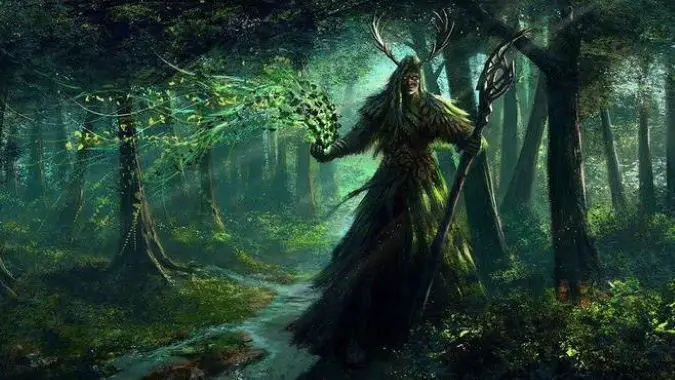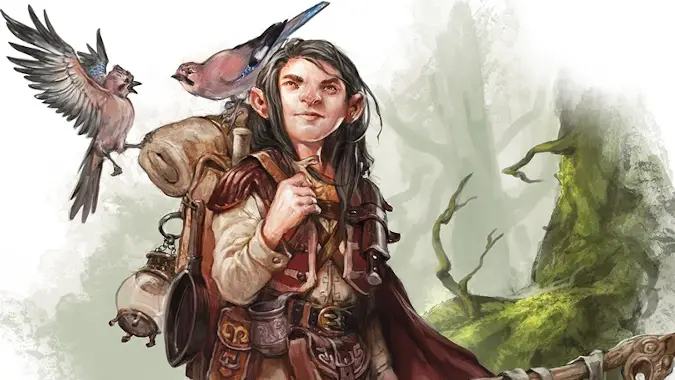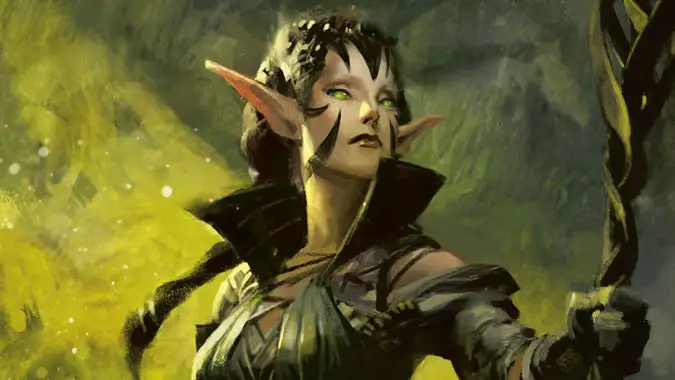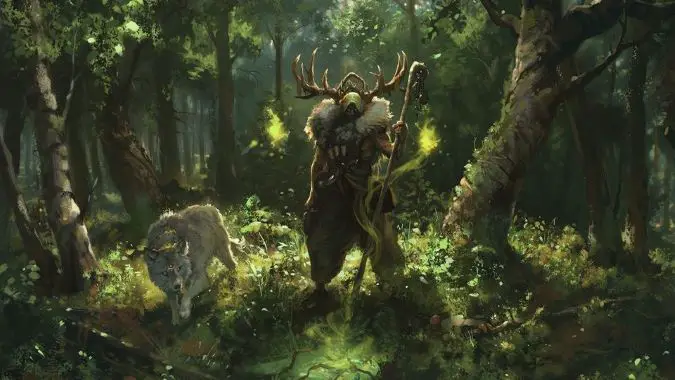One D&D playtest material completely reshapes the Druid

Now that we’ve all had a chance to absorb the results of January’s Open Gaming License controversy, Wizards of the Coast has released a new round of playtest material for the upcoming One D&D. This new packet of Unearthed Arcana includes our first look at the vision for an updated Druid class, and it’s safe to say that out of the changes we’ve seen in prior class playtests, this might be the most thorough set of class changes to be playtested yet.

The reworked Wild Shape — and Channel Nature — are the heart of the Druid in One D&D
The first and most obvious change when you open the playtest material is that Druids now get a new ability at first level: Channel Nature, which you can use to Wild Shape. As Jeremy Crawford explains in the accompanying official video breaking down rationale behind the Druid changes, 5e’s first-level Druid experience was a little lackluster — you got your proficiencies, you got some spellcasting, and you got the Druidic language… and that’s it. Wild Shape wasn’t always core to the Druid in prior editions, but as the game has grown it’s gotten more important and more iconic (and, as he points out, properties based on D&D have also made it more iconic — is that a nod to World of Warcraft there? I’m going to assume so) and so it just made sense to have it available right off the bat.
Unfortunately, as he also points out, the Druid is the least-played class in 5th edition, and that’s partly due to the complexity of Wild Shape. There were a lot of rules about whether you used your own statistics or your shape’s; did you use your own proficiencies, the animal’s, or always take whichever was higher? Are Wild Shape attacks unarmed strikes, or are they some kind of weapon attack? Do you retain your species abilities in Wild Shape form? (That last one’s a doozy: per official tweets from Jeremy Crawford, you retain species abilities unless they explicitly state they require some part of the race’s anatomy to function, which means a Dragonborn Druid retains their breath weapon, but a Tortle Druid does not keep their base Armor Class of 17, because the latter explicitly states it’s due to the Tortle’s shell.) Plus on top of that, subclasses starting in Tasha’s Cauldron of Everything introduced the idea of using your Wild Shape charges to do other things, such as the Wildfire Druid summoning their Wildfire Spirit companion.
That’s all streamlined now. Much like how Clerics and Paladins can Channel Divinity, Druids now gain charges of Channel Nature — two right off the bat, up to four by level 20 — and regain one charge on a short rest and all charges on a long rest. At level 1, you can only use it for Wild Shape, but you also gain other abilities to use your Channel Nature at higher levels, such as the ability to summon spectral healing flowers. Did someone say Efflorescence?
With the positive changes come some downsides, though. You no longer get to copy an exact animal’s stat block for maximum effect; instead, you now have templates, starting with Animal of the Land at 1st level, Animal of the Sea at 7th level, and Animal of the Sky at 9th level, which can represent any animal of that kind or even some kind of hybrid (you know, like that owlbear form from the trailer for Dungeons & Dragons: Honor Among Thieves). These no longer scale by increasing Challenge Rating with your level, either; instead, the majority of their statistics are based off of your Wisdom modifier, such as an Armor Class of 10 + your Wisdom modifier as an Animal of the Land. You also retain the same Hit Points and Hit Dice, which leads to the biggest Wild Shape change of all: when you run out of Hit Points in Wild Shape, you don’t de-shift and go back to your regular Hit Point total — you just start dying. Wild Shape isn’t a big buffer of HP for Druids anymore, and Circle of the Moon Druids aren’t just giant invincible bears from 1st through 5th levels anymore.
In fact, you don’t have to be giant at all. One of the limitations of some animal forms before was their sheer size — turning into a dinosaur in a tiny dungeon hallway was just infeasible. Now, however, you can choose the appearance of your Wild Shape and the size of your Wild Shape separately. Want to be a small elephant, or a large goldfish, or a medium sized bat? Those are all feasible options.
Finally, while it’s not a major rule change, it is an interesting difference from 5th Edition: Druids in Wild Shape in One D&D retain their ability to speak. They do, however, lose all other abilities, including the ability to cast spells. Guess that clears up that whole species ability conundrum!

Druid ability changes for One D&D
What else has changed for Druids? In short, a lot. Here’s a level-by-level breakdown.
- Druids still gain Spellcasting at 1st level, as well as the Druidic language and the aforementioned two charges of Channel Nature, which you can use right off the bat for Wild Shape. The real change comes in proficiencies: rather than being able to wear light and medium armor (with a restriction against metal armor) and wield a specific list of weapons that hearkens back to an earlier edition of the game, One D&D‘s Druid has proficiency with simple weapons and can wear light armor and shields. That’s it!
- The Druid’s spell list — which is now the Primal Spell list — has some new diversity in its spell choices, gaining some spells that it now shares with Rangers, while losing some spells that didn’t seem to fit the “nature magician” theme. Some examples:
- Message, Produce Flame, and Spare the Dying have been added to the list of cantrips.
- Charm Person is gone from the 1st level Primal Spell list, but Ensnaring Strike, Hail of Thorns, and Hunter’s Mark have made their way over from formerly being exclusive to Rangers, opening up some options for a shortbow-using Druid early on.
- Also, almost all healing spells have been moved to the Abjuration school of magic. Why is that important? It’s mostly for the Circle of the Moon, as you’ll see below.
- Level 2: Two more options for Channel Nature:
- Healing Blossoms is the aforementioned spectral healing flowers, which lets you roll a number of d4s equal to your Wisdom modifier and distribute them to creatures within a 10-foot radius as you see fit.
- Your other option is Wild Companion, essentially expending a use of Channel Nature to cast Find Familiar by summoning a nature spirit to you, except your familiar is always a fey, and it always disappears after a long rest.
- Level 3: Subclass choice, as well as your first Subclass ability. the ever-popular Circle of the Moon is the one in this playtest — and it’s changed completely.
- Level 4: Feat
- Level 5: Power improvements to your Animal of the Land form; you unlock its Climb Speed and Multiattack. That’s right: Druids in animal form now get Extra Attack at the same time as more martial classes, preventing them from completely overshadowing those classes at low level.
- Level 6: Another Subclass feature.
- Level 7: Your second Wild Shape form opens up: Animal of the Sea. This form moves slower on land than the Animal of the Land but (obviously) has a swim speed, as well as thirty extra feet of Darkvision and the ability to breathe both air and water. Landshark form is now a reality!
- Level 8: Another Feat.
- Level 9: Hot on the heels of Animal of the Sea, you unlock Animal of the Sky. This form is more lightly armored than the previous two, but gains advantage on Perception checks and the Flyby feature where it doesn’t provoke attacks of opportunity by flying out of reach of an enemy. It also has the best Darkvision of all, at 120 feet.
- Level 10: Another Subclass feature.
- Level 11: More options for Wild Shape size: you can now be a Tiny creature. However, if you do so, you only get to stay Wild Shaped for 10 minutes, and you deal half damage when attacking — but you’re probably hoping to use this option for infiltration, not combat!
- Level 12: Another Feat.
- Level 13: An interesting addition to Wild Shape, Alternating Forms. If you’re in a Wild Shape form, you can now swap back to your normal form as a bonus action, then return to that Wild Shape form anytime within the next minute as a bonus action as well, all without expending any charges of Wild Shape. This opens up, for example, swapping out of your Wild Shape to cast a spell on someone with your action, then returning to your Wild Shape to reposition and multiattack on the next round.
- Level 14: Your final Subclass feature.
- Level 15: Wild Resurgence lets you use Healing Blossoms at the same time that you use Channel Nature to Wild Shape. Two-for-one savings? Don’t mind if I do.
- Level 16: Another Feat.
- Level 17: Gain the ability to cast spells in Wild Shape form, with the exception that you cannot cast a spell that has a non-free material component (such as Resurrection’s costly diamond). This was part of the 20th level Druid capstone ability in 5th Edition.
- Level 18: This is where the old 20th level 5th Edition class capstone abilities were relocated to, so at 18th level the Druid gains Archdruid: whenever you roll Initiative, you regain one use of Channel Nature. This is quite a step down from the ability to use Wild Shape an unlimited number of times per day, but considering the additional uses for Channel Nature now, that might’ve been overpowered. Archdruid also gives you the flavorful ability of very slow aging that used to be the Druid’s reward at 18th level anyway: for every 10 years that pass, you only age 1 year.
- Level 19: Another Feat.
- Level 20: Introduces the new One D&D feature of Epic Boons, which can either be an ability score increase or an Epic Boon Feat. Furthermore, the power level of Epic Boons in this playtest has been ramped up, as they really didn’t feel like a climactic capstone ability for your character — if you reach 20th level in one class, you should now reap the rewards appropriately.

The Circle of the Moon subclass is still focused on Wild Shape, but is all new otherwise
The subclass in this playtest for the Druid is the Circle of the Moon. Formerly, this was the subclass for Druids that wanted to wade into combat in their Wild Shape, and it did so by scaling the Challenging Rating of the beasts you could transform into — although it did so in a strange manner that caused the Circle of the Moon Druid to overshadow nearly all other classes in combat until about 5th level, at which point they fell behind until 10th level, when they could turn into actual elementals.
Well, disregard all that, because One D&D changes this subclass so thoroughly that only two abilities from the old Circle of the Moon survived.
- Level 3: Combat Wild Shape, which is actually a small grouping of other abilities.
- Swift Transformation lets you use Wild Shape as a bonus action. This was something the Circle of the Moon could always do.
- Quick Attack lets you use Unarmed Strike as a bonus action. This one’s very interesting because of how Unarmed Strikes have changed in the playtest. Instead of just being a very weak way for anyone to attack outside of Monks and some Warriors, Unarmed Strike now acts like a regular melee attack, but you choose one of three effects: a small amount of damage, a Grapple, or a Shove that pushes the target away and knocks it prone. This doesn’t necessarily increase the damage of a Wild Shaped Druid, but it does add extra combat flexibility.
- Finally, Abjuration Spells lets you cast any Abjuration-school spell in Wild Shape form as long as it doesn’t have a material component. No need to leave form to cast Healing Word, which is now an Abjuration spell. Or maybe you prefer to Cure Wounds and then use your Quick Attack to shove whatever caused those wounds to the ground? That’s an option now.
- Level 6: Elemental Wild Shape. No, this isn’t the ability to turn into elementals; Circle of the Moon has lost that entirely. Instead, when you assume a Wild Shape you now also choose a damage type: Acid, Cold, Fire, Lightning, or Thunder. While in Wild Shape form you have resistance to that damage type, and your Bestial Strike — the generic attack ability for all three Wild Shape templates — can optionally deal that kind of damage instead of Bludgeoning, Piercing, or Slashing damage. Your forms also take on an appearance of that element, so you might be a cool giant elk with lightning crackling between your antlers, or an icy white shark chilling the water behind you as you swim.
- Level 10: Elemental Strike, which is a far cry from actually turning into an elemental. Instead, your Bestial Strikes now deal a bonus 1d6 damage of the damage you choose with your Elemental Wild Shape, increasing to 2d6 at 17th level.
- Level 14: Thousand Forms, and this one also hasn’t changed: you always have the Alter Self spell prepared, it doesn’t count against the number of spells you have prepared, and you can cast it at will without expending a spell slot.
Overall, this Circle of the Moon rework is extremely interesting. A clear effort was made to avoid the awkward scaling of the old Circle of the Moon, as well as not overshadowing your friends at some levels while being left behind in effectiveness a few levels later. However, its success will depend entirely on how well the new Wild Shape template forms work, and I think the low Armor Class of the forms alone — 10 + your Wisdom modifier for Land and Sea, 8 + your Wisdom modifier for Sky, meaning your Armor Class will usually be around 13-14 in Land form and 11-12 in Sky — might be the biggest downside of trying to maximize Wild Shape. Still, this is a playtest, and actual testing and feedback will hopefully help shore up any problems that arise around this subclass.
Please consider supporting our Patreon!
Join the Discussion
Blizzard Watch is a safe space for all readers. By leaving comments on this site you agree to follow our commenting and community guidelines.
 @awaymessageclub
@awaymessageclub



